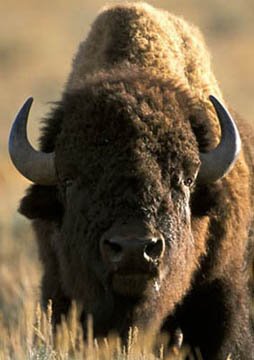 A buffalo relaxes in the grass despite the nearby smoke of a large fire currently burning at Yellowstone National Park.
A buffalo relaxes in the grass despite the nearby smoke of a large fire currently burning at Yellowstone National Park.A fire near the LeHardy Rapids in Yellowstone National Park that began last week has torched about 8,500 acres of the park. The blaze, according to a fire official, has good potential for growth. This summer marks the 20th anniversary of Yellowstone's most devastating fire, which scorched about 37 percent of the park. The final flames of the 1988 inferno, actually a series of fires caused by lightning and human carelessness, weren't extinguished till November of that year, but a Yellowstone visitor in the spring of 1989 left this description of the smoked-over area:
"For most of our time in the park, there was a heavy pall of smoke in the air. Elk and bison in varying stages of consumption stood forlornly in the gray smoke and overcast, breathing hard for precious oxygen. For me, the saddest memory is of the noble bison. These stalwart icons are in no small part symbolic of our national heritage. They are a vision of strength and stamina, but the fire took a toll on them, if not from the flames themselves then from the deadly smoke that lingered long after the flames were abated.
"Granted the smoke took a grim reaping on many animals in the park, but it was the bison that appeared to suffer most. Driving throughout the park, we would see them standing, head down and gasping. Often they stood near geysers and fumaroles for added warmth to ease their pain.
Many of these bison displayed bloody froth draining from their nostrils. Rangers informed us this was an indication that carbon particles from the smoky air had accumulated to a harmful level in their lungs, resulting in not only pneumonia but abrasion to soft lung tissue from the simple act of breathing.
"As the problem progressed, these animals could not even forage for food because of shortness of breath. In time they simply dropped in their tracks and remained there forevermore."
Only nine buffaloes actually perished during the 1988 fire, but it must have been painful to watch the suffering wildlife. Let's hope the current fire, believed to be started by a downed power line, is extinguished as quickly as possible.
"For most of our time in the park, there was a heavy pall of smoke in the air. Elk and bison in varying stages of consumption stood forlornly in the gray smoke and overcast, breathing hard for precious oxygen. For me, the saddest memory is of the noble bison. These stalwart icons are in no small part symbolic of our national heritage. They are a vision of strength and stamina, but the fire took a toll on them, if not from the flames themselves then from the deadly smoke that lingered long after the flames were abated.
"Granted the smoke took a grim reaping on many animals in the park, but it was the bison that appeared to suffer most. Driving throughout the park, we would see them standing, head down and gasping. Often they stood near geysers and fumaroles for added warmth to ease their pain.
Many of these bison displayed bloody froth draining from their nostrils. Rangers informed us this was an indication that carbon particles from the smoky air had accumulated to a harmful level in their lungs, resulting in not only pneumonia but abrasion to soft lung tissue from the simple act of breathing.
"As the problem progressed, these animals could not even forage for food because of shortness of breath. In time they simply dropped in their tracks and remained there forevermore."
Only nine buffaloes actually perished during the 1988 fire, but it must have been painful to watch the suffering wildlife. Let's hope the current fire, believed to be started by a downed power line, is extinguished as quickly as possible.










1 comment:
Tom,
It just breaks my heart when these fires claim wildlife.
I lived in the PNW for several years and the fires there were devastating. What makes it more tragic is when people actually start these fires, even though that's not the case here with the most recent one.
I remember one year when I was living in WA learning of a man who deliberately set a fire that blazed out of control for days in CA. I can't imagine what those firefighters go through trying to contain blazes like that.
Happy trails,
Connie :)
Post a Comment